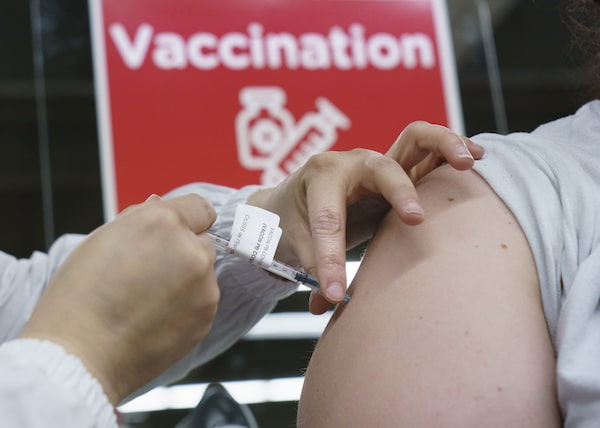
On COVID-19 vaccines there are not two sides, says Globe and Mail public editor Sylvia Stead. The evolving science and the facts behind vaccines are informing the public-health and economic decisions to get all of us vaccinated as quickly as possible.Paul Chiasson/The Canadian Press
A reader e-mailed to say he planned to cancel his subscription because The Globe and Mail was not balanced. I asked in what way, and he said he’s not an anti-vaxxer – he’s had one shot – but he was struck by what he saw as major news in an online comment on an editorial. That comment incorrectly said COVID-19 vaccines had not been approved by health authorities and why would we take something that is just eight months old. The reader argued that The Globe was being Orwellian in supporting those pressing for vaccinations rather than showing both sides.
On this, there are not two sides. The evolving science and the facts behind vaccines are informing the public-health and economic decisions to get all of us vaccinated as quickly as possible. The “other side” is misinformation like that online comment. The vaccines have been approved by Health Canada.
The mRNA platform of the Pfizer-BioNTech and Moderna vaccines has been studied for decades. The first person was given a dose as part of testing in March, 2020. Since then, billions of people have received an approved vaccine and countless lives have been saved.
An article by Damian Garde of Stat News and Jonathan Saltzman of The Boston Globe noted: “After isolating the virus from patients, Chinese scientists on Jan. 10 posted online its genetic sequence. Because companies that work with messenger RNA don’t need the virus itself to create a vaccine, just a computer that tells scientists what chemicals to put together and in what order, researchers at Moderna, BioNTech, and other companies got to work.”
I also hear complaints from people who say the media shouldn’t report possible side effects of the vaccines. They believe that makes the public-health message more complicated, which makes it harder to convince the vaccine-hesitant to get a shot. But while side effects are extremely rare, it is important for people to get the full story, blemishes and all.
That said, any report on potential side effects must include interviews with experts. Anecdotal stories do not replace scientific studies or statistics.
Over the 19 months of pandemic coverage in The Globe, there have been a handful of problems with online headlines lacking context or being unclear, but they were fixed quickly. One recent one said: “Emerging Signs COVID-19 Vaccines May Not Stop Delta Variant, England Says,” but it should have said “May Not Stop Delta Variant Transmission” and was fixed.
The reader said my response debunked his belief, but he still thought The Globe should show both sides on vaccines. While there have been many articles about the reasons some people give for not getting vaccinated, I asked why would we cover anti-science views. There is a public-service responsibility to provide accurate science-based news.
I see the pull of misinformation and confirmation bias. Misinformation from an anonymous commenter online is somehow more exciting than the truth. (Most of those who strongly oppose the vaccines are not this open or polite, to put it mildly.)
Compare this with our current federal election coverage, where there are many reasonable sides to explore.
Political partisans may have made up their minds, but many of you are still considering how to vote and you need to see the facts, analysis and opinions that outline what the parties propose, at what cost and what the likely outcome will be. On election day, the test for Globe and Mail coverage is this: Did it give you everything you need to make an informed choice? Was it balanced and fair to all parties? Was the coverage focused on the issues and the leaders and not too much on the horse race?
Let me know your thoughts on what, if anything, is missing at publiceditor@globeandmail.com and I will write about it next month.
Keep your Opinions sharp and informed. Get the Opinion newsletter. Sign up today.